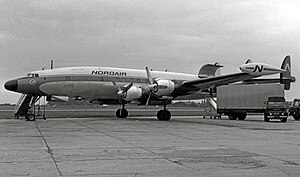Super Constellation
| L-1049 Super Constellation | |
|---|---|
 |
|
| Nordair L-1049H | |
| Role | Airliner |
| National origin | United States |
| Manufacturer | Lockheed Corporation |
| First flight | 14 July 1951 |
| Introduction | 15 December 1951 |
| Status | Retired from commercial service. Preserved examples exist as private aircraft. |
| Primary users |
Eastern Air Lines Trans World Airlines |
| Produced | 1951-1958 |
| Number built | 259 (Commercial) 320 (Military) |
| Developed from | Lockheed L-049 Constellation |
| Variants |
Lockheed C-121 Constellation Lockheed EC-121 Warning Star |
| Developed into |
L-1249 (R7V-2/YC-121F) Super Constellation L-1649 Starliner |
The Lockheed L-1049 Super Constellation is an American aircraft, a member of the Lockheed Constellation aircraft line. The L-1049 was Lockheed's response to the successful Douglas DC-6 airliner, first flying in 1950. The aircraft was also produced for both the United States Navy and Air Force as transport, electronics, and airborne early warning and control aircraft.
Since 1943 Lockheed had been planning a stretched variant of the Constellation family. The first was an L-049 with a fuselage lengthened by 13 feet (4 m). The next was an L-749 lengthened by 18 feet (5.5 m). Neither was built due to the lack of suitable engines on the civilian market.
The idea was relaunched after a rival aircraft appeared, when Douglas launched a stretched version of its DC-6 airliner as a cargo transport, designated DC-6A, for military and civil operators. Douglas was soon to launch a passenger version (the DC-6B) that could carry 23 more passengers than Lockheed's current production L-749 Constellation.
In 1950 Lockheed had repurchased the XC-69 Constellation prototype from the Hughes Tool Company. The XC-69 then had four Pratt & Whitney R-2800 radial engines instead of the Wright R-3350s on production models (Lockheed had made that installation on the prototype to test the R-2800 as a possible engine option for the L-049). Lockheed lengthened XC-69 by 18 feet (5.5 m), to become the basis for the L-1049 Super Constellation. The aircraft first flew later that year still fitted with R-2800 engines, then was refitted with R-3350 956-C18CA-1 engines with jet stacks for slightly increased thrust. Later modifications included strengthened landing gear and larger vertical stabilizers. Eastern Air Lines ordered 10 aircraft, while Trans World Airlines (TWA) followed with an order for 14. The L-1049 had some 550 improvements and modifications compared to the L-749, including greater fuel capacity, rectangular windows, larger cockpit windshields and improved heating and pressurization.
...
Wikipedia
